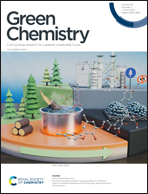Recent advances in biomass pretreatment using biphasic solvent systems
Abstract
The complexity and recalcitrance of lignocellulosic biomass seriously hinder its subsequent conversion to liquid fuels. To achieve high-value utilization of lignocellulosic biomass, the physical–chemical barrier should be overcome through appropriate pretreatment techniques to improve the accessibility of cellulose for efficient enzymatic hydrolysis. With the rapid emergence of novel pretreatment solvents, biphasic solvent pretreatments represent a nascent and green pretreatment method that has shown outstanding advantages and broad application prospects in the biorefinery of lignocellulosic substrates due to its ability to provide economically viable biomass upgrading, the separation process for products in the solvent phase, and the reutilization of solvents. Herein, different types of biphasic solvents (e.g., 2-methyltetrahydrofuran, methyl isobutyl ketone, 1-butanol, phenoxyethanol, ionic liquids, and deep eutectic solvents) were reviewed systematically, including the fundamental designs of biphasic solvents for biomass pretreatment, their effect on the fractionation of individual biomass components (e.g., carbohydrate and lignin) and the enzymatic hydrolysis performance, and the coproduction of furan and hydroxymethylfurfural. Finally, the main pros and cons of these different biphasic solvent systems are summarized, and the future development direction is also proposed. This review can provide a reference for designing and selecting effective biphasic pretreatment methods for various types of lignocellulosic biomass.

- This article is part of the themed collection: 2023 Green Chemistry Reviews


 Please wait while we load your content...
Please wait while we load your content...